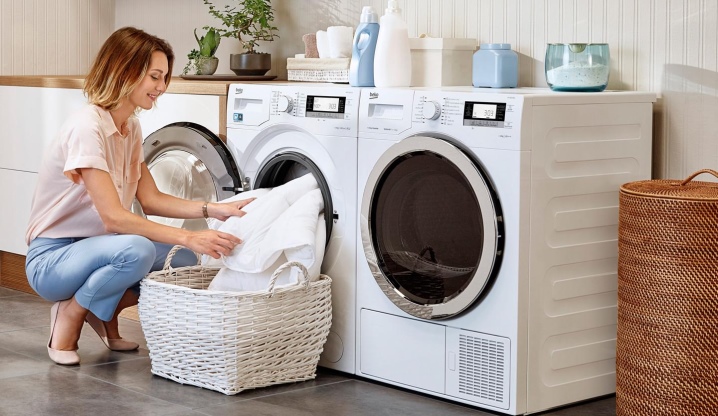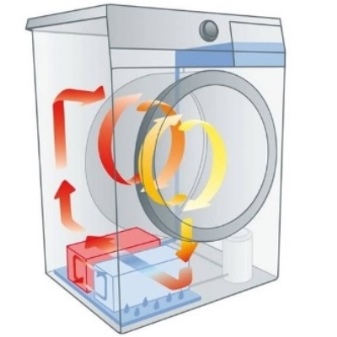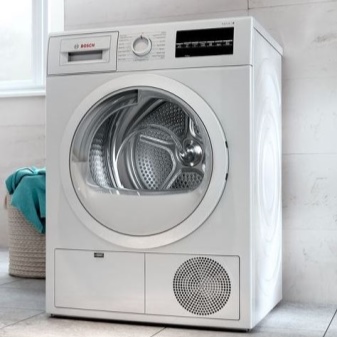How to connect a tumble dryer?

Automatic machines for quick drying help to quickly get ready for work or on the road, are an indispensable assistant after washing bed and baby linen. However, in order for the equipment to work harmoniously, to perform its functions efficiently, when installing it, it is necessary to take into account the characteristics of a particular room and the conditions for laying communications. If you follow the instructions exactly, then you can do it yourself to connect the dryer to the sewer, drain and ventilation without the involvement of specialists.

Features of connection to communications
Today, installations for drying clothes are no less relevant and in demand on the farm than automatic washing machines. They are especially convenient in apartments of multi-storey buildings, where there are no balconies and loggias, and you have to dry things in the apartment after washing. The way the dryer is installed and connected depends on the model. There are 3 types of units:
- Exhaust type. It is intended to be connected to a home ventilation system or to outdoor exhaust pipes with a turbo exhaust hood. The linen is placed in a special cabinet and dried by hot air treatment, which is subsequently removed through a corrugated hose.


- Condensing type. A more convenient option, since only a connection to the mains is required for operation. Heated air is supplied to the rotating drum under pressure, it knocks moisture out of the laundry, and then passes through a special heat exchange unit. In it, the air flows are cooled and in the form of condensate flow into a separate plastic container, the water from which is removed after each drying process.


- Evaporative type. Some models require a drain connection. The principle of operation is similar to the previous version - hot air removes moisture from the laundry in a rotating drum. The difference is that the exhaust air is not cooled, but rather heats up in a special evaporator. The condensate formed from the vapors then flows through a drain hose into the drain or into a built-in container, depending on the model.


Dryers with a hood and drainage of liquid into the sewer are, as a rule, larger in size, but they also dry more laundry. Such installations are considered stationary - the need to connect to communications limits the choice of installation locations. Condensing models with a plastic container for collecting water are much more mobile - they are installed not only on the floor or in a built-in wardrobe, but also on a washing machine in the form of a pencil case. They are very popular among owners of small-sized apartments, since they do not need to re-equip communication lines to start.
These models save space in the room and do not need outlet hoses and fluid pipes.

Indoor mounting options
The complexity of connecting the device largely depends on the choice of the installation site. In residential buildings and apartments, dryers are usually installed as close as possible to the washing machine - it is convenient to overload the laundry, there are communications for draining and connecting to the network.
Four main installation methods:
- vertically on a washing machine;
- in line with the washer;
- in a closet or drywall niche;
- under the surface of the kitchen countertop.



In some models with a drain hose, when connecting, a certain level must be maintained with respect to the laying of the sewer pipe.
Installation should be carried out in such a way that the hose at the outlet of the dryer is at least 10-15 cm above the drain with a distance of up to 1 m... If the distance is greater, then with each next meter the height should increase by 5-7 cm.
Required tools
Most modern manufacturers include a set of tools necessary for connecting with the device. However, they are often not enough - the connection procedure largely depends not only on the model, but also on the specific place, installation conditions. To correctly connect the dryer to communications with your own hands, it is necessary to prepare certain tools and fixtures.
- Construction knife - required to cut the outlet water or air hoses.
- Clamping clamps for fixing the corrugation... If a soft corrugated air outlet hose is connected, it is better to use plastic clamps.
- Screwdriver and pliers for attaching and clamping hose clamps. It is not recommended to use other available means, especially when tightening the metal clamp. Your hand could be seriously injured if a non-intended tool is released from the clamping head.



In individual cases additional tools may be needed. For example, if the outlet in the wall does not match the dimensions, you will have to use a hammer drill or hammer drill to enlarge the opening. If you need to "cut" into a plastic sewer pipe, it is convenient to use a hacksaw for metal or special plumbing scissors for pipes.
Stages of work
The dryer must be connected only after complete installation - the device must be firmly fixed in the case of vertical installation, stand securely on its legs when placed in a linear arrangement... This is especially important if a drum dryer is connected - vibration can lead to disconnection of pipes and hoses... Depending on the model chosen, the connection is carried out in three stages.
Connection to ventilation
Before connecting the dryer, make sure that the length of the hose corresponds to the distance from the installation site of the unit to the outlet in the wall. In the case of using a corrugated pipe, it should not be taut.
Connection process.
- Using a clamp, fasten the flexible air exhaust hose to the ventilation hole of the dryer. - in most models it is included in the package and has a standard length. It is more convenient to tighten the clamp with a screwdriver, and at the end, clamp it all the way with pliers so that it does not fly off when pulling on the hose.
- Connect the other end of the hose to the outlet pipe of the air duct and also fix the attachment point with a clamp... Route or pull the hose so that there are no kinks or creases.


When installing dryers with powerful forced air exhaust fans, the outlet hose can be brought out through the window or window, if there is no possibility of connecting to a special ventilation shaft.
It is important to ensure that the lifting height of the hose to the outlet in the wall is at least 0.5 m.

Installing the drain hose
The process of installing the drain hose of the drying unit is similar to connecting a washing machine - one end of the hose is already securely fixed by the manufacturer in the unit's housing, while the other end is simply connected to the sewer system. For a dryer, it is advisable to build a separate tee into the plastic drain pipe - this will exclude possible leaks at the junction. You need to control so that the diameter of the branch pipe of the tee matches the diameter of the hose.
If a flexible hose is used without a special plastic tip for connecting to the pipe, then it must be secured with a metal clamp with a rubber gasket - without it, the clamp can damage or break the hose.

In some modern models, manufacturers provide the owner with a choice - to use a built-in plastic container to collect liquid or connect the unit to a city sewer. The first option is more mobile and does not require any work, however, if possible, it is better to bring the hose into the drain pipe - this will extend the life of the dryer. So, the constant excessive presence of liquid inside the structure, although to a small extent, still negatively affects electrical devices, metal and rubber elements.



Electrical connection
A tumble dryer is a large household appliance, therefore it is recommended to connect a separate line from the junction box to connect it.
To avoid electric shock, especially during power surges, use only a grounded power outlet.

All modern models of dryers have a complex electrical filling - computer circuits and boards, which are adversely affected by sudden power surges. Therefore also it is advisable to install a separate circuit breaker. When installed in a kitchen or bathroom, it is necessary to correctly foresee the location of the outlet - so that water does not subsequently get on it.
Connect the land to the outlet only with dry hands.
How to connect a tumble dryer in a bathroom, see below.













Recently we bought a tumble dryer, tried to install everything ourselves, but unfortunately it didn't work out! You have very useful information in the article that can help you when installing drying equipment.
The comment was sent successfully.